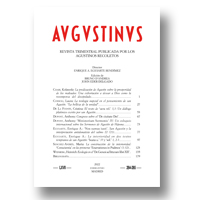|
21.
|
Augustinus:
Volume >
63 >
Issue: 248/249
Vittorino Grossi
La herencia de san Agustín en la Iglesia y en la Teología
abstract |
view |
rights & permissions
| cited by
The article presents some guidelines to read St. Augustine’s Works, and also the transmission of his thought through the Ages, since it is still a source of Theological and Ecclesiologial Research. The article focuses on four aspects: The Intercultural Context we have now a days, the Intercultural Context of the Late Antiquity; the hints left by the same St. Augustine to read his Work, and the main Ideas that conform his legacy.
|
|
|
22.
|
Augustinus:
Volume >
63 >
Issue: 248/249
Pablo Irizar, Guinevere Rallens, Charles Kim
Uniendo lo humano y lo divino. La gramática, la ontología y la forma del lenguaje en la conversación de san Agustín en Ostia (conf. 9, 24)
abstract |
view |
rights & permissions
| cited by
The fracturing of language at Babel (Gn 11.1-9) is one of the defining events which, for Augustine, gives language its current fallen characteristics and limitations. But does the fallen state of language necessarily imply that language creates a chiasm rather than a bridge between the human and the divine? And if so, is language used in vain to invoke God? This paper addresses these questions through an analysis of the role of language in Augustine’s Ostia ascent narrative (conf. 9, 24). According to a first line of interpretation, language creates a chiasm rather than a bridge between the human and the divine in the ‘Ostia ascent’. According to a second line of interpretation, though fractured, language does not create a chiasm but rather a bridge between the human and the divine. By identifying and intertextually analyzing three facets of the function of language in conf. 9, 24, namely the grammatical, the ontological, and the modal, this paper aims at substantiating the second line of interpretation. Part one explores Augustine’s use of the expression per uerbum (Jn 1.1-15) to analyze the grammar of human and divine language. Part two analyzes the ontological function of language as a mechanism of mediation by showing that the ascent in conf. 9, 24 is similar to the structure of manifestation evident in the transition from forma dei to forma serui (Phil 2.6-7) in Augustine’s s. 264. Finally, part three shows that for Augustine, the conversion from the schola superbiae of rhetoric pride to the humility of the schola pectoris implicitly requires the mode of language as a precondition for ascent in conf. 9, 24. As such, this paper concludes, the three facets of language, namely the ontological, grammatical and modal, function in conf. 9, 24 to unite, mediate and transform the human experience of the divine.
|
|
|
23.
|
Augustinus:
Volume >
63 >
Issue: 248/249
Joseph Lam
La alegría del evangelio. Leyendo la ‘Evangelii Gaudium’ del Papa Francisco con san Agustín
abstract |
view |
rights & permissions
| cited by
The article offers a synopsis of the ecclesiological vision of Pope Francis, underlining the centrality of Charity that is what should guide the Evangelization of the Church within a secularized context. The role of the «missionary disciples» in this task, which is a work of mercy, is also pointed out. Later the article presents the illumination of the Augustinian doctrine to the encyclical Evangelii Gaudium, particularly concerning the preaching, as a service of charity, where the pastor gives voice to the message of God. The article also stresses S. Augustine’s doctrine of the Interior Master in relationship with preaching.
|
|
|
24.
|
Augustinus:
Volume >
63 >
Issue: 248/249
Graziano Malgeri
Fundamento Antropológico de la esperanza en san Agustín
abstract |
view |
rights & permissions
| cited by
The article presents, in its first part, a response to some scholars who criticize the eschatological conception of St. Augustine, as is the position of H. Arendt, M. Nussbaum, and G. Wehr who accuses St. Augustine of having neutralized the eschaton, to later present the purely theological character of the Augustinian concept of hope. It also describes the anthropological foundation of the actio-contemplatio, in which Augustine’s idea of hope has its roots.
|
|
|
25.
|
Augustinus:
Volume >
63 >
Issue: 248/249
Mauricio Saavedra, Enrique Eguiarte
San Agustín y la encíclica ‘Laudato Si’ ‘. Una presencia en la ausencia
abstract |
view |
rights & permissions
| cited by
The article is an Augustinian commentary of the encyclical Laudato Si’ of Pope Francis, to stress those points in which the Pontiff’s thought could have been illuminated with the ideas of Saint Augustine. The article discusses some of the ecological clues that St. Augustine develops in his own Works, trying to demonstrate that the thought of Saint Augustine is present in the absence in Pope Francis’ Laudato Si’.
|
|
|
26.
|
Augustinus:
Volume >
63 >
Issue: 248/249
Tamara Saeteros, Enrique Eguiarte
Breve reseña bibliográfica sobre san Agustín y la ecología
abstract |
view |
rights & permissions
| cited by
The article offers an overview of the main bibliography on the subject of Saint Augustine and Ecology. After an overview, the article focuses on the work of Scott Dunham, Trinity and Creation in Augustine. An Ecological Analysis (2008) and subsequently the collective work edited by John Doody, Kim Paffenroth and Mark Smillie, Augustine and the Environment (2015).
|
|
